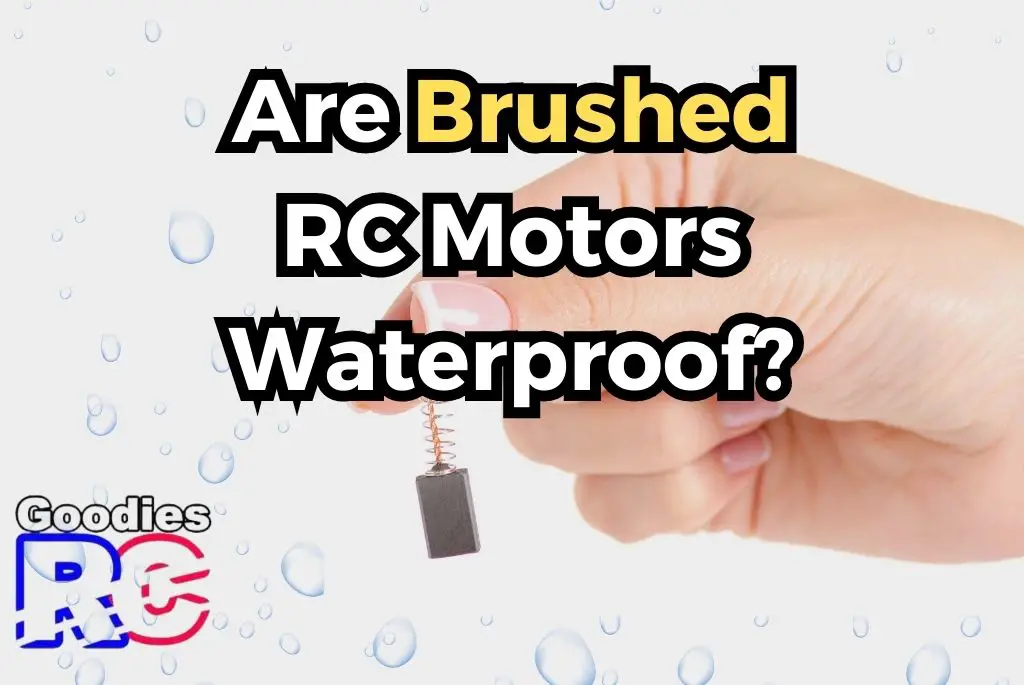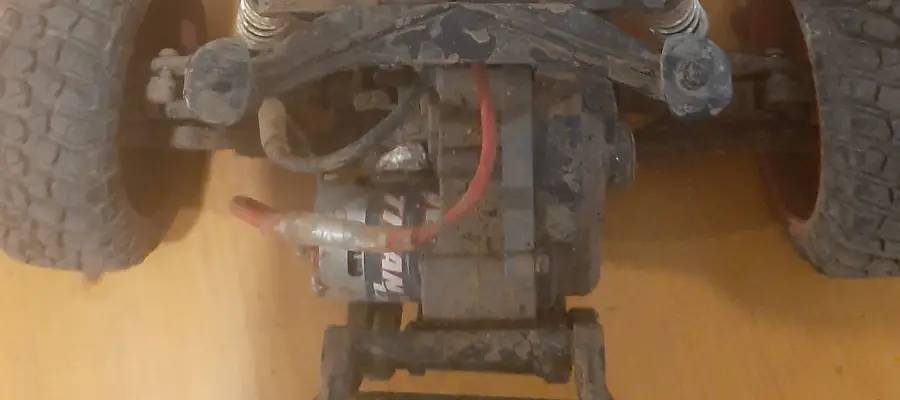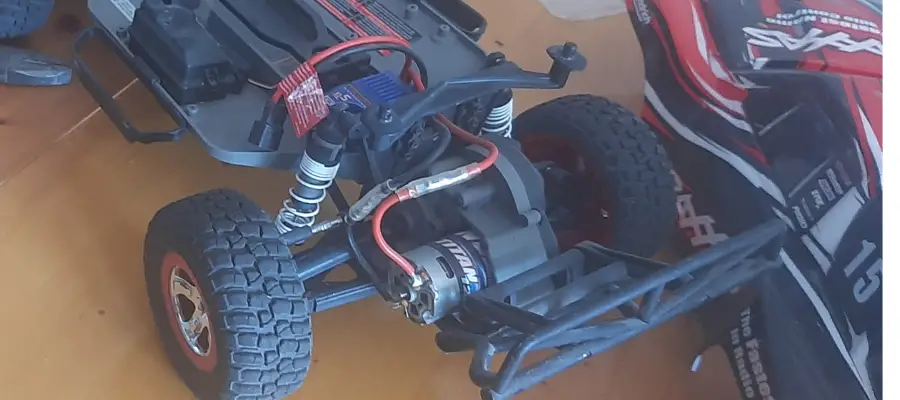A brushed motor is pretty much the answer when it comes to affordable and reliable performance. They may not have the lifespan and efficiency of their brushless counterparts, but are they waterproof?
Generally, brushed RC motors are not inherently waterproof, but some manufacturers offer waterproof or water-resistant versions. So it depends on the specific motor and its design features. Water causes corrosion inside electrical motors which is what ultimately destroys them.

Standard brushed RC motors consist of a housing that contains the brushes, commutator, and windings. These components are not normally designed to be fully sealed or protected from water intrusion. So exposing a regular brushed motor to water or other liquids can cause damage and significantly reduce its lifespan.
Due to the popularity of RC vehicles used in wet and muddy environments, some manufacturers have developed waterproof or water-resistant brushed motors. These motors incorporate additional design elements to provide a level of protection against water getting inside.
Waterproof brushed motors normally have sealed casings, which prevent water from entering the internal components. They may also have rubber or silicone gaskets around the motor shaft and wire connections to further enhance water resistance. These design modifications help to prevent water from reaching the brushes, commutator, and windings and therefore reduce the risk of water damage.
It’s important to note that while waterproof or water-resistant brushed motors can withstand splashes, damp conditions, and brief submersions in water, they’re not designed for prolonged or deep underwater use. Submerging a motor beyond its specified water resistance rating can still result in damage.
When considering whether to use a brushed motor in wet environments, check the motor’s specifications provided by the manufacturer. Look for terms such as “waterproof,” “water-resistant,” or an IP (Ingress Protection) rating, which indicates the motor’s level of protection against solids and liquids. To learn more, I highly recommend checking out my guide about can a brushed RC motor get wet.
Can Brushed Motors Run Underwater?
Some brushed motors can run underwater. For instance, click here to check out the submarine brushed motors (on Amazon).
But in general, brushed motors are not designed to run underwater. While many brushed motors may have limited water resistance or be marketed as waterproof or water-resistant, they are generally not intended for continuous operation in submerged conditions. Even with water-resistant features, prolonged or deep underwater use can still lead to motor failure or damage.
When a brushed motor operates underwater, several issues can arise. Water can interfere with the motor’s electrical connections, causing shorts or malfunctions. The water can also disrupt the proper functioning of the brushes and commutator, which rely on friction and contact to transfer electrical power. Water can cause corrosion and rust which degrades the motor’s performance over time.
While some hobbyists may temporarily submerge their RC vehicles with brushed motors for short periods, I recommend you keep the motor as dry as possible at all times. If you want to operate an RC vehicle underwater or in wet conditions for extended periods, it is advisable to explore alternative options, such as waterproof brushless motors, which are specifically designed to handle water immersion and provide better long-term performance and reliability in wet environments.
If you do run through water, clean the motor out by following the instructions further below.
Always refer to the manufacturer’s guidelines and specifications for the specific motor you are using to understand its limitations and suitability for underwater operation.
I highly encourage you to check out my guide about whether or not RC cars are capable of running on water.
How To Clean Out An RC Motor

- Disconnect the power
Before you start cleaning, disconnect the wiring and remove the battery, to prevent any accidental activation of the motor during the cleaning process.
- Remove the motor
It’s usually best to remove the motor from the RC for cleaning if you’re able to. Follow the manufacturer’s instructions or consult the vehicle’s manual to safely remove the motor.
- Rinse off loose debris
Run some clean water over the motor to rinse off any loose mud or debris. Avoid using high-pressure water or submerging the motor, as this can force water into sensitive areas and potentially cause more damage.
- Use a brush or toothbrush
Take a soft brush or a toothbrush and gently scrub the motor’s exterior, including the casing and the vents, to remove any remaining dirt or mud. Be careful not to apply excessive force or push debris into the motor’s internal components.
- Use compressed air

If you have compressed air, use it to blow away any stubborn dirt or debris that may be lodged in crevices or hard-to-reach areas of the motor. This can help dislodge particles without the need for excessive scrubbing.
- Check for water intrusion
Inspect the motor for any signs of water intrusion, like moisture or water droplets inside the casing. If you suspect water has entered the motor, allow it to thoroughly dry before reassembly or further operation. You can use a clean cloth or paper towel to gently absorb any excess moisture.
- Lubricate if necessary
Depending on the motor’s design and manufacturer’s recommendations, you’ll need to apply a small amount of lubrication to specific areas, such as the motor bearings, to maintain smooth operation. Use a suitable lubricant designed for RC motors and apply it sparingly according to the manufacturer’s instructions.
See my article: Is WD40 Good For RC Cars?
- Reinstall the motor
Once the motor is clean, dry, and properly lubricated (if necessary), reinstall it according to the manufacturer’s instructions. Ensure all connections are secure and properly tightened.
If you frequently run your RC vehicle through muddy or wet conditions, consider investing in a motor specifically designed for water resistance or a fully waterproof model to minimize the risk of damage.
To learn about RC motor maintenance, I highly encourage you to check out this guide on how to clean and maintain a brushed RC motor.
What Are The Disadvantages Of A Brushed Motor?
Limited efficiency
Brushed motors are less efficient compared to brushless motors due to the friction and wear caused by brushes and commutators, resulting in energy losses and reduced overall performance.
Higher maintenance
The brushes in brushed motors wear out over time and need periodic replacement, adding to the maintenance and operating costs.
Lower power output
Brushed motors generally provide lower power output compared to brushless motors, which can limit their performance in high-demand applications.
Reduced lifespan
The brushes and commutators in brushed motors are subject to wear and tear, leading to a shorter lifespan compared to brushless motors.
Compared to brushless options, brushed RC motors have more disadvantages. The limited efficiency of brushed motors translates into shorter runtimes and decreased battery life compared to their brushless counterparts. This can be a significant drawback for those seeking extended playtime or longer racing sessions.
Additionally, the higher maintenance requirement of brushed motors, with the need for regular brush replacements, can become an inconvenience and add to the overall cost of ownership. Brushed motors’ lower power output and reduced lifespan further contribute to their inferiority when compared to brushless motors, which offer superior performance, longer lifespan, and lower maintenance needs.
How Long Do Brushed RC Motors Last?
Generally, a well-maintained brushed RC motor can last up to 3000 hours of runtime and beyond. However, the actual lifespan depends on things like build quality, frequent and prolonged usage, high speeds or heavy loads, overheating, and poor maintenance.
To maximize lifespan, follow manufacturer guidelines for maintenance, including cleaning, lubrication, and timely brush replacement. Brushed motors have a shorter lifespan compared to brushless options, making brushless motors a preferred choice for those seeking longer-lasting and more durable RC motors. Brushless motors can last around ten times longer than brushed motors, 20 000 to 30 000 hours if they’re maintained well.
What Causes A Brushed Motor To Fail?

Brush Wear
The brushes in a brushed motor produce friction and cause wear as they come into contact with the commutator. Over time, the brushes become worn down which results in diminished motor performance and eventually leads to motor failure.
Commutator Damage
The commutator, which helps transfer electrical current to the motor’s coils, can also suffer damage. Excessive wear, overheating, or improper maintenance can cause the commutator to become rough or uneven, leading to poor electrical contact and potential motor failure.
If you also have a brushless motor RC device, then I highly recommend you to check out this guide where I outline all the causes of brushless RC motor failure.
Overheating
Operating a brushed motor at high temperatures can cause damage to the internal components. Excessive heat can degrade the insulation on the motor windings, resulting in shorts or motor malfunctions.
Continuous or prolonged operation without allowing the motor to cool down can accelerate overheating and contribute to motor failure. Now this was all about brushed motors, but are you curious about brushless motors? Then check out this guide on whether or not brushless RC motors burn out.
Excessive Load or Stress
Brushed motors have their limits in terms of power and torque. Subjecting them to heavy loads or excessive stress can strain the motor and its components, potentially leading to failure. Pushing the motor beyond its capabilities, such as running it at high speeds or with heavy payloads, can cause premature wear and damage.
You may also like to read my detailed blog post about do brushless RC motors lose power over time.
Moisture and Contamination
While brushed motors may have some resistance to moisture, excessive exposure to water or other contaminants can lead to corrosion, short circuits, and motor failure. Moisture can penetrate the motor’s interior, causing damage to the electrical components and reducing their functionality.
In Summary
Standard brushed RC motors are not waterproof, and exposing them to water can damage them. However, there are waterproof or water-resistant brushed motors available on the market that offer varying degrees of protection against water ingress.
If you plan to operate your RC vehicle in wet or damp conditions, I advise investing in a motor specifically designed for water resistance or considering other alternatives like waterproof brushless motors, which generally offer better waterproofing capabilities. Always consult the manufacturer’s specifications and guidelines to ensure before you choose a motor for your specific needs.
I hope you enjoyed reading this article. You may find this article to be of interest: How Wet Can RC Cars Get? Read This Cool Guide

